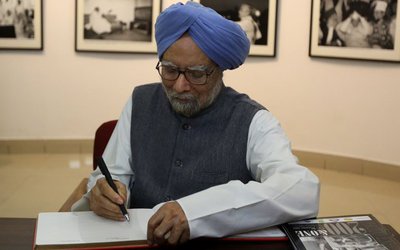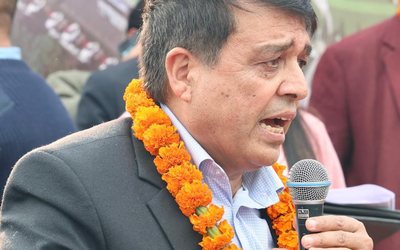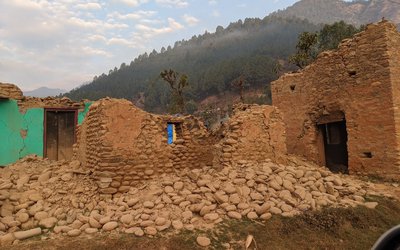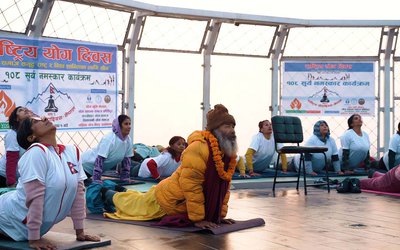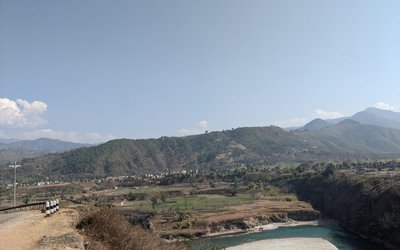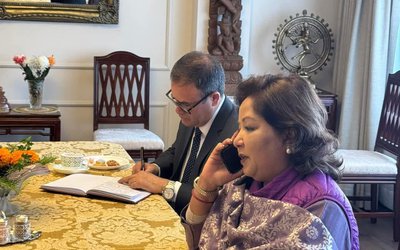Students in government schools who have been ushered in class X, having been “passed” in class IX examinations find themselves in a quandary. On the one hand, they are delighted not to have “failed”. On the other, they are dismayed at the way the push for online classes leaves them bereft of learning from peers in physical classrooms and one on one instructing that many public schools had offered its students. At a price of course. “Free” education in government schools is a misnomer for many schools. Students pay for the coaching class, they pay for educational excursions, and now they are paying for computers and internet connections to study.
Several of class VIII, IX and X students who I coach, find themselves struggling to understand what is being taught. It has been several months of “no study” so getting back to the “virtual classroom” is not easy. Learning from home is not as easy either. The Zoom connections being used for classes are not robust, the teacher’s sound fading in and out, and their internet connectivity at a price many can ill afford. Many if not all, government schools do not have access to unlimited Zoom. This allows only 40 minutes of Zoom access at a time. Students get logged out automatically and have to rejoin after 40 minutes. Not all the students get in immediately and thus lose out on precious minutes. When they do get to rejoin they may have missed out up to 5 or 10 minutes. Missing out on what the teacher has said, often leaves them scrambling to catch up, and if they cannot, leaves them confused and demoralized.
One of the students asked me why government schools could not find a way to enable poor students to purchase computers at a subsidized rate with equal monthly installments. How can students from a poor family spend Rs 10,000 or more at once for a device with the necessary storage space to download Zoom for one child? What happens if they have two or more children in different classes? Would they be able to afford purchases of three different devices? After all, the student asked me, all students in Class X will have to clear the class X examinations so would have had to pay for the computer. Another student shared his concern about why their school had not taken up the offer from NTC or Ncell that provides subsidized internet access for students, once their respective educational institutions have vouched for them as bona fide students. They rattle off the names of other educational institutions, public and private both, which have already availed of it for their students.
While these questions are practical in view of the current and immediate needs, and hopefully are being addressed by the respective schools, it was the comment from the student who had just enrolled in class VIII that rattled me.
Having just arrived from her village where she had studied till class VIII in an English medium “boarding school” she was forced to re-enroll in class VIII in the city. The Principal of the government school she had enrolled in here had told her parents that her Nepali was weak, her English was weaker and her knowledge of Mathematics was non-existent. Nepali was not her mother tongue, so this was understandable. The Mathematics teacher had left, and it had been months before a new one came in before leaving again. English class was also often taught in a way that was incomprehensible hence learning was out of the question. However, these practical issues are pervasive in many schools which is why aspiring parents often send their children to the city so as to get a better education. However, there is no bridge course provision in government schools in the city that provides newly enrolled students from the village with coaching in subjects to help them catch up with the rest of the class.
This student shared with me how she was considered an expert among her classmates back in her village at making doko (baskets woven using bamboo strips) which she had learned during her vocational classes. She also had started learning thanka (a style of painting) and showed a beautiful rendering of the mandala, that was half-finished. A few of her earlier paintings had been bought by tourists who had visited her village homestays en route to trekking. The money she earned had been spent on buying some gardening tools and seeds. She grew her own tomatoes, knew the best season in which to plant gourd, to keep her kitchen garden patch free of weeds. She even knew the right measures to use for preparing organic pesticides. She asked me, “What will I learn in school here? Will it help me earn?”
How could I tell her that for the next few years she would probably not have time for her thanka, that her school in the city will not value her skills in making dokos, and that at the end of three years, if she scores low marks, she is also considered a “poor performer”. How could I tell her that her budding talent in the painting may probably be forced to wither away, her gardening skills may be unrecognized, and that by the time she is in class X she may despair of being “employable”. The irony here is that currently she probably is potentially more employable (already having a marketable skill), more knowledgeable about the plant kingdom (tending to her own kitchen garden) than many of her peers in the city classroom. After a few years of being crammed with 40 or 50 other students in a small classroom with teachers “doing their part” and leaving in a hurry for more lucrative pursuits like “tuition” she will in effect be rendered unemployable.
A major reason for this is the way the education system in Nepal is designed leaves little space for students to really learn. Sparsely resourced government schools are hardest hit as they have to operate in spaces that leave little room for libraries, playgrounds, laboratories, or small group work. Chances are that the school library if it does exist has few “reference” books, none about Nepali literature, or fiction writers, no computers with internet connectivity. Playgrounds are generally pocket size and often not maintained, and more likely to only allow space for a few students at a time. Science labs were never a part of the school agenda, and sports equipment are unheard of in many of the schools. Ironically, about 25% of the final examination marks are for “Practical” while the rest is for “Theory”. Students in the cities who pass out from Class X are as yet “unqualified” for the job market. They must go on and pass Class XII to be even considered to be in the right track for it.
In other words, very few of the government schools in Kathmandu valley would meet the gold standard set by the government’s own Child-Friendly School Indicator Guidelines. Schools that have been singled out for philanthropic donations by Rotary Club, Lion’s Club, or specific countries are exceptions. Durbar High School, Nandi Raatrito name a few are shining examples of how schools can be turned around in terms of infrastructure with targeted funds actually spent for the purpose they were raised for.
The student who questioned me in her innocence had thus opened up a Pandora box. Was this how the education system operated the world over?
During my research, I came across sources that cited the Finnish education system as being considered among the best in the world. They too had struggled with poor performers, the dissonance between education and the market till a few decades ago. What had changed? Today, the reformed Finnish education system has no standardized tests taken either for entry into a school or a university. Yet, students strive for excellence, aim to learn more, achieve more and interestingly while doing so, are rarely stressed out. Homework for school goers is designed to take up to fifteen minutes of a student’s time on average per day. Examinations are distant memories, replaced by more innovative ways to assess a student’s level of knowledge. The emphasis is on getting the young to be better human beings. Classes are designed for enabling a grasp of the fundamentals of the 3Rs that lives in the memory and used in daily life instead of being regurgitated and forgotten once the exams are over.
In the US too, a quiet revolution has slowly been weaving its way into the scholastic assessment system. Several educational institutions of higher learning are viewing GMAT, GRE, SAT scores differently than before. Tests are being deemed discriminatory, non-essential, and only providing uni-dimensional profiles of a student’s multi-dimensional capabilities. Educational reformers are unhappy and strongly advocating for an overhaul stating that the education system is out of sync with the current and emerging workforce needs besides becoming less and less competitive globally.
India too has taken a highly welcomed revolutionary step. It is changing the way in how its young citizens will be schooled, doing away with annual examinations for each grade except for grades 3, 5 and 8. Its recently unveiled Education Policy 2020 gives a glimpse of a long term visioning, with phase wise plans going up all the way till 2040 for now, with longer-term plans yet to be divulged maybe. A council for higher education will be formed providing strategic direction in the way education will be harnessed to meet its rapid economic growth and beyond. As the details get unpacked, it will be riveting to see how India transforms its youths and harnesses the best minds for the future.
In a way, the COVID 19 is pushing the education system in Nepal out of its comfort zone and challenging its sense of complacency. With online systems underway, students will be pushed to learn on their own. Their access to the internet is expected to fuel their curiosity and their learning curve may actually shoot up. With access to visually displayed knowledge at their fingertips about hydrocarbons, electrical transmissions, solving algorithms, they may now seek to learn differently, challenging the very teachers who have been advocating learning by rote. Individuals often benefit from a combination of Visual, Audio, Reading and Kinesthetics (VARK) when learning. Schools in Nepal focused more on Audio and Reading. The push for virtual learning has opened up access to the internet, which in itself is a vast learning portal.
With such changes happening, and rapidly, what can the future hold for its education system? It does seem that the pandemic may actually provide an opportunity for students in Nepal to learn quicker, better and hunger for more. With radical changes being ushered in the neighboring doorsteps, it should prompt Nepal to critically review its own education system, most importantly its schools. It may need to also review the statistics of youth migration and unemployment with more gravity, particularly in view of nose-diving returns from the remittance. It may need to actually do its “homework” in a comprehensive assessment of course curriculum, physical space requirements for schools, a ranking and rating system that looks into skills promotion as much as it does in “knowledge” system. Are the course books truly helping the children learn? The policy review process that specializes in a top-down closed-door approach may need to open up and change radically. It may mean inviting participation from civil society. Experienced educational specialists and academicians, unemployed youths, current students and their parents, are all nuggets of precious learning that can be used to reform a system that long needs an overhaul. If Nepal is to survive the pandemic and move ahead in the future, making the education system robust is a key way to go.
- Going To Work In The New Normal
- Sep 10, 2020
- Sarathi Venture
- Mar 05, 2018
- Multi Grade Coaching Classes
- Dec 13, 2016

